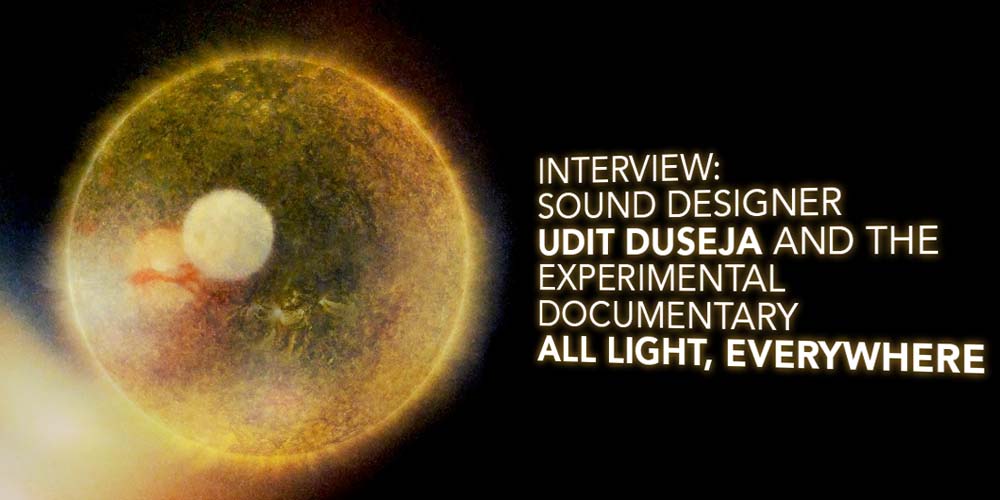All Light, Everywhere is a film from Baltimore-based filmmaker Theo Anthony (Rat Film) about the intersection between filmmaking and surveillance, and the work of sound designer Udit Duseja wraps it in subtle sonic tension.
In All Light, Everywhere, viewers will see the world from satellite images of inner-city neighborhoods to ground-level police body cam footage. The film dives into the world within those two distant points to touch on surveillance’s significant cultural and technological aspects. What philosophical debates should we have when it’s so easy for tech to be objective and logical, but also open to manipulation and abuse? The film is part documentary, part experimental art-house film with an important message to deliver.
PopAxiom spoke with Udit Duseja about becoming a sound designer and creating the pseudo-science fiction sounds of All Light, Everywhere.
Global Sound
Udit began life in a small city in India named Gwalior. “It’s got a lot of culture and history. As a child, I learned and practiced Indian classical music there, which trained my ear and laid the foundation of understanding sound.”
“Later in life, I moved to Mumbai where I met people working in the film industry. I started as an intern, learning on the job and quickly learned how adding sound to a picture can change the meaning or bring a film alive.”
Following Mumbai, Udit did a Master’s course in Edinburgh then moved to London. He’s been working on American, British, and Indian films ever since.
“Every sound you add to a film is sort of self-conscious,” Udit explains his philosophy. “You have to make sure the sounds have meaning. Then, you can shape the narrative within an audience.”
Is working with sound learned or understood? To Udit, it’s a skill that develops the more someone works, but can also be a knack. “You can’t teach someone to have a musical ear. But it develops too.”
“It’s also so collaborative,” Udit explains the final truth in being a sound professional in the film industry. “The cinematography might inform the way I design a shot. Everything informs how you approach the film, which ultimately comes from a director.”
For Udit, good directors are the ones that give others the freedom to express themselves. Although every project is different and comes with its challenges, he finds “comfort being in a studio environment and exploring what I can do with sound.”

About All Light, Everywhere
“I met Theo through America, a short film that I worked on that won awards and even became an installation at MOMA,” Udit explains. The short caught the eye of director Theo Anthony, who liked the sci-fi, atmospheric sound and found it interesting. He wanted Udit to do what he’d done in the past, but more minimally.
In Udit’s words, All Light, Everywhere is an “experimental documentary film” produced by Memory Sandbox, and distributed by Neon. “It’s a take on surveillance and weapons. It finds narratives within that subject. How guns and cameras overlap; the whole idea of ‘shooting’ something.”
“It goes into archives and comes back,” he explains. “It’s a brilliant film. So, for me, it was about creating a minimal atmospheric sci-fi documentary soundscape. I tried to create unexpected connections between technology, weapons, and surveillance. So, the outcome was to illustrate critically the effect those things have on our lives.”
The film was crafted in the edit. The structure was as if the archive images were interacting with computer screens and surveillance software shots. “You go from archive to the future,” Udit says. “So the idea for me was to illustrate that in sound. The invasive-ness of technology. How it’s changed and changed us over the years.”
“The soundscape was built using room tone buzzers and subtle electromagnetic sounds to represent the technology always looking at you,” he continues. “The shots allowed me to do that. There’d be off-screen mouse clicks, crackles, and beeps to create tension that would build with each scene.”
Working with Udit’s design was composer Dan Deacon’s score. “He already laid his music down when it came to me. So there was a lot of room for the sound to help tell the story. The mix was also done very loud, almost like an assault on the viewer, then it cuts to a lot of silence and little technical sounds.”
“The sound wants to put you in the history,” he declares, “It was a lot of fun to use the theme of minimal sound design.” However, his initial approach utilized more sound. “They knew what they wanted, and we stripped it back. It was a great collaboration. Rather than just being more like a sound effect, the purpose of the soundscape was to create an atmosphere.”
Wrapping Up
Udit’s work is versatile but with a love-lean into one genre. “I would love to work on a science fiction film. That’s the genre I can get into. But anything works!”
“I’m working on a film based in Nepal and directed by an Italian director about a tiger cub and a kid,” he says about one of two projects he’s working on but can’t discuss just yet. “I’ve recently finished an audio play installation that’s borderline sci-fi / post-apocalyptic from British artist Aliyona Larinova. It’s about two sisters exploring storytelling while there’s an apocalypse outside. It is quite interesting and fun to create the world inside and outside their room without any visual reference!
Is All Light, Everywhere on your watch list?
Thanks to Udit Duseja and Impact24 PR
for making this interview possible.
Find more interviews from Ruben R. Diaz!


